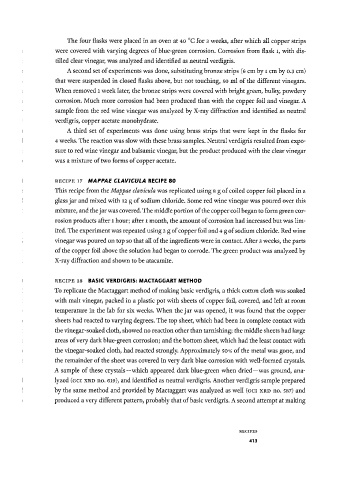Page 430 - Copper and Bronze in Art: Corrosion, Colorants, Getty Museum Conservation, By David Scott
P. 430
The four flasks were placed in an oven at 40 °C for 3 weeks, after which all copper strips
were covered with varying degrees of blue-green corrosion. Corrosion from flask 1, with dis
tilled clear vinegar, was analyzed and identified as neutral verdigris.
A second set of experiments was done, substituting bronze strips (6 cm by 1 cm by 0.3 cm)
that were suspended in closed flasks above, but not touching, 50 ml of the different vinegars.
When removed 1 week later, the bronze strips were covered with bright green, bulky, powdery
corrosion. Much more corrosion had been produced than with the copper foil and vinegar. A
sample from the red wine vinegar was analyzed by X-ray diffraction and identified as neutral
verdigris, copper acetate monohydrate.
A third set of experiments was done using brass strips that were kept in the flasks for
4 weeks. The reaction was slow with these brass samples. Neutral verdigris resulted from expo
sure to red wine vinegar and balsamic vinegar, but the product produced with the clear vinegar
was a mixture of two forms of copper acetate.
RECIPE 17 Μ Α Ρ PA Ε CLAVICULA RECIPE 80
This recipe from the Mappae clavicula was replicated using 8 g of coiled copper foil placed in a
glass jar and mixed with 12 g of sodium chloride. Some red wine vinegar was poured over this
mixture, and the jar was covered. The middle portion of the copper coil began to form green cor
rosion products after 1 hour; after 1 month, the amount of corrosion had increased but was lim
ited. The experiment was repeated using 2 g of copper foil and 4 g of sodium chloride. Red wine
vinegar was poured on top so that all of the ingredients were in contact. After 3 weeks, the parts
of the copper foil above the solution had began to corrode. The green product was analyzed by
X-ray diffraction and shown to be atacamite.
RECIPE 18 BASIC VERDIGRIS: MACTAGGART METHOD
To replicate the Mactaggart method of making basic verdigris, a thick cotton cloth was soaked
with malt vinegar, packed in a plastic pot with sheets of copper foil, covered, and left at room
temperature in the lab for six weeks. When the jar was opened, it was found that the copper
sheets had reacted to varying degrees. The top sheet, which had been in complete contact with
the vinegar-soaked cloth, showed no reaction other than tarnishing; the middle sheets had large
areas of very dark blue-green corrosion; and the bottom sheet, which had the least contact with
the vinegar-soaked cloth, had reacted strongly. Approximately 50% of the metal was gone, and
the remainder of the sheet was covered in very dark blue corrosion with well-formed crystals.
A sample of these crystals—which appeared dark blue-green when dried—was ground, ana
lyzed (GCI XRD no. 619), and identified as neutral verdigris. Another verdigris sample prepared
by the same method and provided by Mactaggart was analyzed as well (GCI XRD no. 587) and
produced a very different pattern, probably that of basic verdigris. A second attempt at making
R E C I P E S
413

